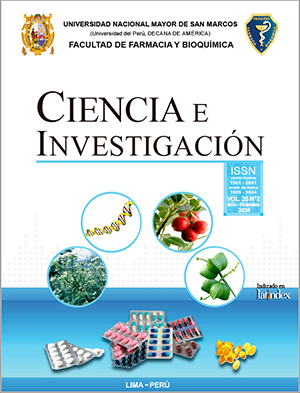Phenotypic and genotypic characterization of Vibrio parahaemolyticus isolated from Argopecten purpuratus from Sechura Bay (July 2017-2018)
DOI:
https://doi.org/10.15381/ci.v26i2.27498Keywords:
Vibrio spp., Argopecten purpuratus, toxigenic genes, biochemistry, phenotypic, genotypicAbstract
Vibrio parahaemolyticus is a gram-negative bacterium that lives in marine environments and estuaries, made up of toxigenic and non-toxigenic strains. Virulent strains are mainly isolated from hydrobiological resources and products, whose ingestion can cause health problems in people who consume them. Objective: To characterize the phenotype and genotype of Vibrio parahaemolyticus strains isolated from scallop (Argopecten purpuratus) production areas in Sechura Bay from July 2017 to July 2018. Methodology: 203 samples collected from Sechura Bay were analyzed. Phenotypic characterization was carried out according to ISO 21872-1 and FDA-BAM standards, while genotypic characterization was carried out according to ISO 21872-1. Results: 97 strains of Vibrio parahaemolyticus (45.8%) were isolated from 203 samples analyzed. All isolates from the chromogenic culture medium confirmed the presence of the VptoxR gene, no strain confirmed the presence of the tdh gene, and only one strain (1%) confirmed the presence of the trh gene. Conclusion: There is evidence of a large variation in phenotypic characteristics, possibly due to the environmental setting. However, the proportionality between the different references on the biochemical profile is closely related to certain peculiarities. The use of a chromogenic agar detects Vibrio parahaemolyticus strains with great accuracy, which are validated by detecting the toxR gene (VpTox). Finally, there is a low probability of detecting strains containing the tdh gene.
Downloads
Published
Issue
Section
License
Copyright (c) 2024 José C. Silva, Roxana E. Céspedes, Jessica K. Espinoza, Julio R. Ruiz

This work is licensed under a Creative Commons Attribution 4.0 International License.
LOS AUTORES RETIENEN SUS DERECHOS:
- Los autores retienen sus derechos de marca y patente, y tambien sobre cualquier proceso o procedimiento descrito en el artículo.
- Los autores retienen el derecho de compartir, copiar, distribuir, ejecutar y comunicar públicamente el articulo publicado en la Revista Ciencia e Investigación (por ejemplo, colocarlo en un repositorio institucional o publicarlo en un libro), con un reconocimiento de su publicación inicial en la Revista Ciencia e Investigación.
- Los autores retienen el derecho a hacer una posterior publicación de su trabajo, de utilizar el artículo o cualquier parte de aquel (por ejemplo: una compilación de sus trabajos, notas para conferencias, tesis, o para un libro), siempre que indiquen la fuente de publicación (autores del trabajo, revista, volumen, numero y fecha).






